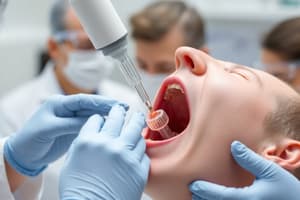Podcast
Questions and Answers
Which type of hemolysis is indicated by a greenish color on a blood agar plate?
Which type of hemolysis is indicated by a greenish color on a blood agar plate?
- Zeta-hemolytic
- Alpha-hemolytic (correct)
- Beta-hemolytic
- Gamma-hemolytic
What is considered significant bacteriuria in urine cultures?
What is considered significant bacteriuria in urine cultures?
- 200,000/ml of mixed organisms
- 100,000/ml of one type of organism (correct)
- 10,000/ml of one type of organism
- 50,000/ml of one type of organism
Which organism is the most common cause of urinary tract infections (UTIs)?
Which organism is the most common cause of urinary tract infections (UTIs)?
- Streptococcus pyogenes
- Escherichia coli (correct)
- Klebsiella pneumoniae
- Staphylococcus aureus
What method is used to create anaerobic conditions for certain pathogens?
What method is used to create anaerobic conditions for certain pathogens?
Which type of pathogen relies on the presence of oxygen to grow?
Which type of pathogen relies on the presence of oxygen to grow?
Which type of hemolytic bacterium is characterized by clear zones of hemolysis on a blood agar plate?
Which type of hemolytic bacterium is characterized by clear zones of hemolysis on a blood agar plate?
What color change indicates the absence of oxygen when using a methylene blue strip in a GasPak system?
What color change indicates the absence of oxygen when using a methylene blue strip in a GasPak system?
Which of the following is a biological vector for disease transmission?
Which of the following is a biological vector for disease transmission?
What is the primary purpose of a clean catch urine sample?
What is the primary purpose of a clean catch urine sample?
Which of the following is NOT a method of disease transmission through vectors?
Which of the following is NOT a method of disease transmission through vectors?
Flashcards
Hemolysis Types
Hemolysis Types
Different ways bacteria affect red blood cells (RBCs) on a blood agar plate.
A-hemolysis
A-hemolysis
Partial breakdown of red blood cells (RBCs) on a blood agar plate, creating a greenish zone around the bacteria.
B-hemolysis
B-hemolysis
Complete breakdown of red blood cells (RBCs) on a blood agar plate, forming a clear zone around the bacteria.
Y-hemolysis
Y-hemolysis
Signup and view all the flashcards
UTI Diagnosis
UTI Diagnosis
Signup and view all the flashcards
Anaerobic Pathogens
Anaerobic Pathogens
Signup and view all the flashcards
Aerobic Pathogens
Aerobic Pathogens
Signup and view all the flashcards
Biological Vectors
Biological Vectors
Signup and view all the flashcards
Mechanical Vectors
Mechanical Vectors
Signup and view all the flashcards
GasPak System
GasPak System
Signup and view all the flashcards
Study Notes
Throat Cultures
- Bacteria in throat feed on blood iron.
- Blood agar plates are used, containing 5% sheep's blood for hemolysis assessment.
- Alpha-hemolysis: Partial breakdown of red blood cells (RBCs), producing a greenish discoloration. Example: Streptococcus pneumoniae.
- Beta-hemolysis: Complete breakdown of RBCs, creating clear zones around bacterial colonies. Example: Streptococcus pyogenes.
- Gamma-hemolysis: No RBC breakdown, no color change.
Urine Cultures
- Diagnose Urinary Tract Infections (UTIs), usually caused by E. coli.
- Use Eosin Methylene Blue (EMB) and Blood Agar (BA) plates.
- Procedure:
- Collect urine in a sterile container.
- Clean the genital area before urination (for clean-catch method).
- Collect mid-stream urine ("clean catch"). Urine is sterile in the body, but becomes contaminated as it leaves.
- Significant bacteriuria is indicated by >100,000 bacteria/ml of a single organism.
- E. coli is common due to its presence in the intestinal tract and proximity to the urethra.
- Samples must be tested or refrigerated immediately to prevent rapid growth and inaccurate results.
Anaerobic Pathogens
- Anaerobic: Bacteria that do not require oxygen to grow.
- Aerobic: Bacteria that require oxygen to grow.
- Obligate anaerobes: Bacteria that cannot tolerate oxygen.
- Facultative anaerobes: Can grow with or without oxygen.
- Procedure (for anaerobic cultures):
- Inoculate a Tryptic Soy Agar (TSA) plate with the bacteria sample.
- Use a GasPak system (special jar with sachet and methylene blue strip) to remove oxygen. Place plates in the jar and seal.
Vectors
- Vectors: Organisms that transmit disease causing microbes.
- Types of transmission:
- Food or water
- Respiratory droplets
- Sexual contact
- Types of Vectors:
- Human vectors: Insects (flies, mosquitos, ticks, mites)
- Mechanical vectors: Carry microbes on their bodies (e.g., a fly landing on food).
- Biological vectors: Carry microbes within their bodies (e.g., a mosquito bite transmitting malaria).
- Control difficulties: Eradication is challenging because all vectors must be eliminated.
- Control methods: Use insecticides and insect repellents.
Studying That Suits You
Use AI to generate personalized quizzes and flashcards to suit your learning preferences.




